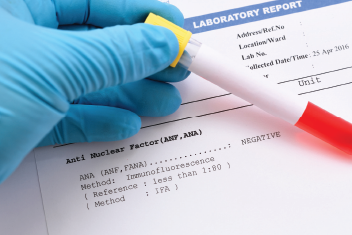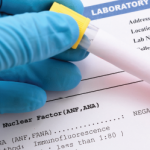
Jarun Ontakrai / shutterstock.com
How laboratories define a serological hallmark of systemic lupus erythematous and which assays they use to detect it could contribute to misclassification of patients identified as anti-nuclear antibody (ANA) negative, according to researchers.
Most people who have lupus test positive for ANAs as part of an immunology screening for autoimmune disorders. The presence of ANAs is considered an important lupus classification criterion, but some patients are misclassified because their test results are considered ANA negative, say the authors of a study published recently in Arthritis Care & Research.
“ANA positivity is traditionally defined as the presence of an indirect immunofluorescence (IIF) staining pattern localized to the nucleus, while isolated cytoplasmic and mitotic cell patterns (CMPs), although staining positive by IIF, often are not reported or classified as ANA positive and are not included in the ANA test reports by some laboratories,” states the article.
Simply put, not all lupus antibodies display nuclear patterns under IIF staining—a common ANA testing method—and instead can show up as a cytoplasmic pattern, explains lead author May Choi, MD, FRCPC, rheumatology clinical lecturer at the Cumming School of Medicine, University of Calgary, and Alberta Health Services, Canada. This means if a lab is not testing or not reporting cytoplasmic patterns as positive, “they are potentially missing important antibodies,” she says.
Test results can vary among labs for different reasons, including what types of assays are used, says Dr. Choi. In addition, insurance reimbursement policies may prompt some labs to skip checking for CMPs altogether and only test for nuclear patterns, she says.
The Study
The result of the misclassification is that some patients who actually have lupus may be overlooked and go undiagnosed or may not qualify for clinical trials, says Dr. Choi. To get a better handle on how often this happens, researchers studied the prevalence of IIF anti-cellular antibody staining among patients at inception of lupus, relevant because ANA testing is usually ordered at the beginning, when doctors are trying to make a diagnosis, she says.
“It’s also believed that the ANA can change over the disease course, so we wanted to study patients near the time of diagnosis,” says Dr. Choi.
The study looked at patients who were considered ANA positive if their lab test showed a nuclear pattern, as well as other patients who had ANA with cytoplasmic and mitotic patterns only.
“We found a small percentage of the patients were CMP positive, and a small percentage of these patients who would have otherwise been called ANA negative,” she says.
Researchers used baseline serum of patients in the Systemic Lupus International Collaborating Clinics inception cohort to detect anti-cellular antibodies by IIF on Hep-2000 substrate. The three subsets examined were ANA positive, which showed the presence of either nuclear or mixed nuclear/CMP staining; anti-cellular antibody negative, which lacked intracellular staining; and isolated CMP staining.
All tests from the study were conducted at one central lab, the Mitogen Advanced Diagnostic Laboratory at the University of Calgary.
“We wanted to standardize everything to one location” because of the variability that can exist between centers and different assays, says Dr. Choi.
Study results revealed that out of 1,137 newly diagnosed lupus patients, the majority or 92% (1,049) were ANA positive, according to the article. Among the remaining patients, 6.2% (71) were anti-cellular antibody negative and 1.5% (17) had an isolated CMP.
The findings reveal that given the traditional definition, patients from the latter group would identify as ANA negative, even though they have antibodies directed against a variety of CMP targets, the article states.
“So these patients may have been misclassified as ANA negative,” says Dr. Choi.
Clinical & Research Relevance

Dr. Choi
Dr. Choi advises rheumatologists to learn early on, in detail, how a laboratory conducts and reports results from ANA testing and specifically what type of assays are used. For example, ANA screening that doesn’t detect CMP patterns could potentially miss the presence of anti-ribosomal P, an antibody often considered a key biomarker for neuropsychiatric lupus and lupus hepatitis, she says.
A misclassification could also make it difficult for a patient to qualify for a clinical trial if the physician suspects lupus but the lab results are negative for ANA. This is relevant now more than ever because of new European League Against Rheumatism/ACR classification criterion that requires a lupus patient to be ANA positive, says Dr. Choi.
“It’s really important that when a rheumatologist is ordering these tests to understand what exactly their ANA is telling them,” she says, adding it’s also important to know how the lab reports it.
The authors note a changing spectrum of ANAs is evolving to include CMPs. This development has led to a debate about whether to change the terminology to “anti-cellular antibodies” to address the increasing clinical relevance of CMPs.
“I think it’s going to be very hard to move away from the (ANA) terminology because historically that’s what everyone has been calling it,” says Dr. Choi “It technically makes more sense to call it anti-
cellular now, just because it makes it clearer that we are looking at the whole cell, not just the nucleus.”
Meanwhile, the International Consensus on Antinuclear Antibody Patterns Committee considered a reclassification of ANA to include CMPs, but ultimately decided to delay action on the matter, recognizing that current criteria are predicated on a more traditional definition, according to the article.
What’s Next
The authors foresee a decrease in the prevalence of anti-cellular antibody-negative lupus to correspond with a shift in emerging nomenclature guidelines toward including non-nuclear patterns in ANA reporting.
“I think the prevalence of true ANA-negative lupus is quite uncommon … .” says Dr. Choi. “As labs report cytoplasmic patterns and mitotic patterns to be ANA positive that number … will continue to go down.”
Dr. Choi and her colleagues plan a follow-up study with the same cohort to investigate whether patient ANA should be tested not solely in the beginning to diagnose lupus but also throughout the course of the disease.
“We are looking at all these patients again and repeating their serologies on multiple assays to compare the performance of the ANAs in each of these assays,” says Dr. Choi.
“We’re going to take a look at what a lupus patient’s ANA does over their disease course and whether that is affected by things like medication and disease activity,” she says “The hope is that this will provide more information to the rheumatologists so that when they order the ANA test, they can better interpret what the test means.”
Catherine Kolonko is a medical writer based in Oregon.
Reference
- 1Choi MY, Clarke AE, St Pierre Y, et al. Antinuclear antibody-negative systemic lupus erythematosus in an international inception cohort. Arthritis Care Res (Hoboken). 2019 Jul;71(7):893–902.

